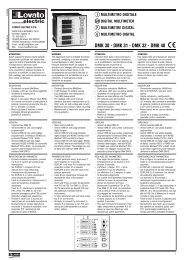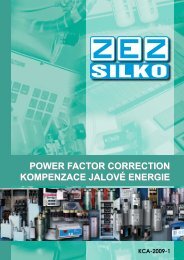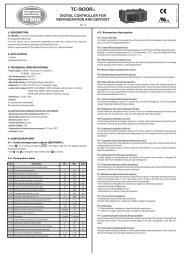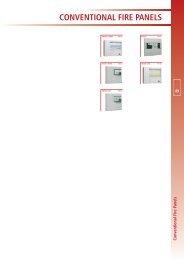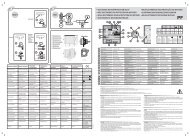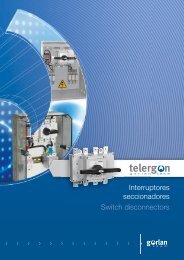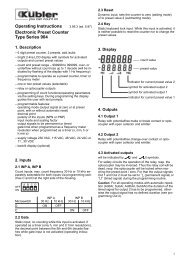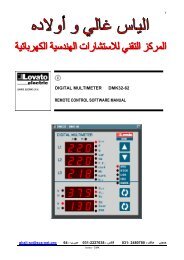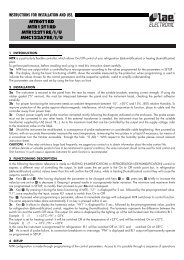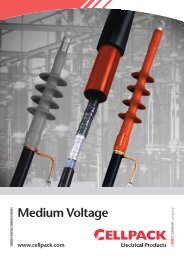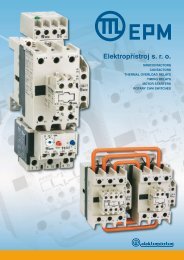NOVAR 1106 / 1114 / 1206 / 1214 NOVAR 1xxx / S400 NOVAR ...
NOVAR 1106 / 1114 / 1206 / 1214 NOVAR 1xxx / S400 NOVAR ...
NOVAR 1106 / 1114 / 1206 / 1214 NOVAR 1xxx / S400 NOVAR ...
Create successful ePaper yourself
Turn your PDF publications into a flip-book with our unique Google optimized e-Paper software.
<strong>NOVAR</strong> <strong>1xxx</strong> EPM Elektropřístroj s. r. o.<br />
decimal point (as opposed to fast flashing decimal point to identify a disabled section – see description<br />
further below).<br />
The controller measures the sections continually within the control process as they are connected and<br />
disconnected. It evaluates the average value measured for each not-yet-precise section and, when<br />
having received about 100 values, it rewrites the original section value, which was obtained in the<br />
automatic section power recognition process, with it. At the same time it tags the section as ―precise‖<br />
and stops further accurization of such a section.<br />
This way, possible inaccuracies in the automatic section power recognition process are removed.<br />
If the sections’ values are specified manually (using the switching program and smallest capacitor<br />
power or by editing section value in parameter 25), no subsequent accurization takes place. Neither is<br />
accurization of choke sections, if present, carried out.<br />
If the automatic section power recognition process is enabled, the accurization process can be<br />
automatically started anytime during the control process as well. If the controller detects that<br />
a compensation capacitor has repeatedly been showing a value different from that measured in the<br />
automatic section power recognition process and the difference is not in order of magnitude (that is in<br />
the interval from a half to double value) from the value recorded in the controller, the accurization<br />
process for such a section will start. Thus effects of changes in compensation capacitor values, for<br />
example as a consequence of the forming process after installation or due to aging etc., can be<br />
eliminated.<br />
4.3 Faulty Section Indication and Disablement<br />
In the alarm setting (parameter 30) you can choose alarm indication or actuation from detecting a<br />
faulty section (section error).<br />
If at least one of these functions has been set, the controller continually checks reactive power<br />
changes in the power system during the control process as the sections are connected and<br />
disconnected and compares them with each section’s power recorded. If connecting and<br />
disconnecting a section does not repeatedly result in adequate change to reactive power in the power<br />
system (or a change to reactive power measured is very different from the capacitor’s value recorded),<br />
the controller tags such a section as faulty and, if relevant alarm actuation has been set, it will disable<br />
the section and stop using it in further compensation temporarily.<br />
Alarm indication can be used for section disablement indication (see description of parameter 30). If<br />
alarm actuation is not set, the controller will only tag the faulty section, trigger alarm indication, but will<br />
keep using the section in compensation. A particular faulty section can be identified by fast flashing<br />
(about three times a second) decimal point in the section value display in the side branch of parameter<br />
25 (as opposed to slowly flashing decimal point identifying not-yet-precise section – see description in<br />
chapter above).<br />
A section that has been temporarily disabled is periodically, about every five days, checked by<br />
including it in compensation for one switching operation. If the controller detects a relevant response<br />
in the power system (within adequate allowance) to connecting the section, it will include the section in<br />
the control process again and, if the automatic section power recognition process is enabled, it will run<br />
accurization process for it too. This way, for example, a repaired section is automatically included in<br />
compensation (after replacing section fuse, for instance).<br />
If the controller does not put a disabled section back to compensation automatically, such reinclusion<br />
in the control process will take place in the following situations:<br />
power supply interruption or controller initialization (see description further below)<br />
editing the section’s value or one of parameters 21 through 23 (switching program,<br />
smallest capacitor value, number of capacitors).<br />
42



